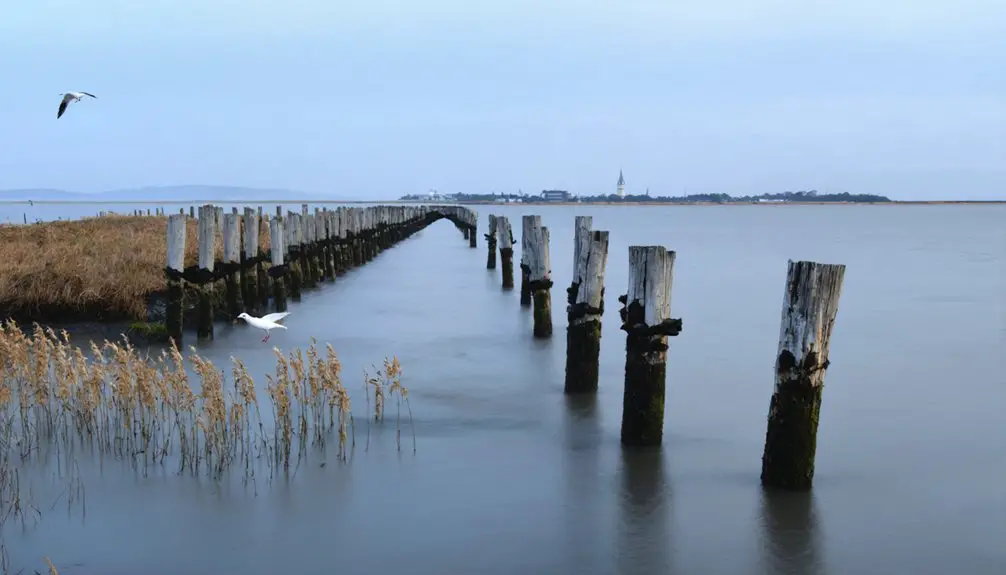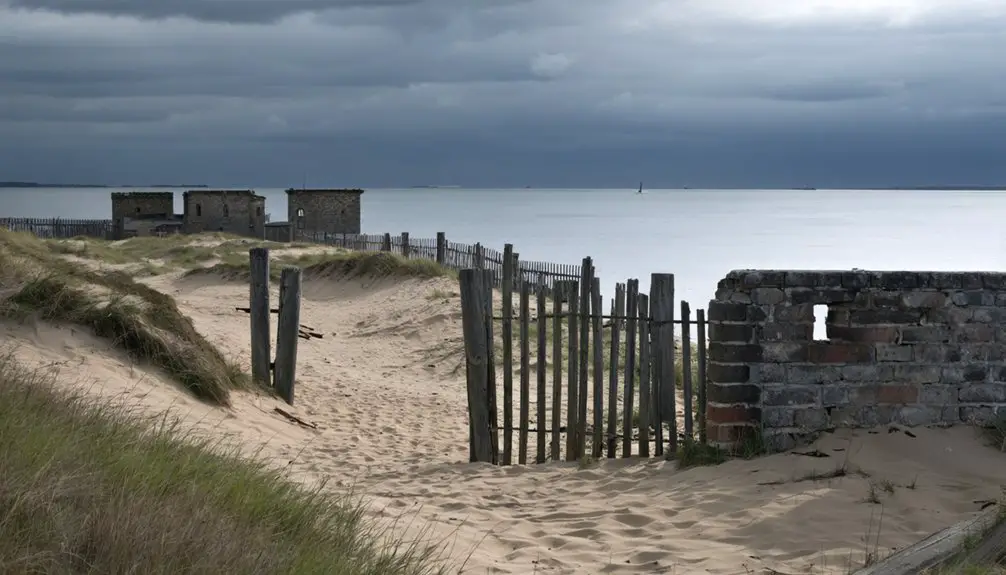You’ll find Long Point’s remains at the outermost tip of Cape Cod’s Provincetown Harbor, where a thriving fishing settlement once stood from 1818 to the 1850s. The community of 38 fishing families built homes, a schoolhouse, and a lighthouse while harvesting cod and producing salt. In a remarkable feat of engineering, residents floated their entire houses across the harbor to Provincetown proper, leaving behind countless stories of maritime ingenuity and determination.
Key Takeaways
- Long Point settlement began in 1818 and grew into a thriving fishing community with 38 families by 1846.
- The community had essential infrastructure including a lighthouse, post office, school, and bakery during its peak period.
- Residents primarily sustained themselves through cod fishing and salt production, with nine windmills operating for salt manufacturing.
- In the 1850s, about 30 homes were floated across Provincetown Harbor as families abandoned the settlement.
- By the Civil War, Long Point became essentially deserted, with only two houses remaining, transforming into a ghost town.
The Birth of a Coastal Settlement
While Cape Cod’s early colonists had long utilized its coastal resources, Long Point’s permanent settlement didn’t begin until 1818 when fisherman John Atwood built the first house on this narrow peninsula.
The settlement’s strategic location provided direct access to rich fishing grounds, attracting pioneers like Prince Freeman and Eldridge Smith who followed Atwood’s lead. Their settlement strategies mirrored those of the indigenous Wampanoag people, who’d previously used the area for fishing, hunting, and agriculture. By 1846, the thriving community had grown to include 38 fishing families. Initial land management followed the colonial practice of having commonly held grazing areas.
You’ll find evidence of the community’s swift growth in the birth of Prince Freeman Jr. in 1822, the first child born on Long Point.
The settlers’ wives contributed to the fishing economy by hand-knitting sweep seines, establishing a pattern of family involvement that would define this budding maritime community.
Rise of the Fishing Community
As Long Point’s strategic location drew more settlers in the 1840s, the fishing community flourished into a bustling maritime hub operating 20 to 30 boats daily. You’d find fishermen setting out at dusk, their boats laden with nets, working the rich waters until dawn. Under the guidance of Nathaniel E. Atwood, the settlement’s fishing practices gained recognition from prominent scientists of the time.
By 1846, the settlement had grown to 38 fishing families with 260 residents, transforming from a sparse outpost into a vibrant maritime village. The community’s prosperous salt production industry generated up to 336,000 pounds annually, making it a significant contributor to Provincetown’s economy.
From scattered homesteads to a bustling port, Long Point blossomed as 38 fishing families built their maritime dreams together.
- Each boat carried 3-4 tons and cast 10-15 nets nightly, using mast lights and bells for safety
- Fishing techniques evolved from basic seining to complex operations yielding 75-barrel hauls
- Your predecessors mastered diverse methods, from mackerel seining to cod fishing with dories
The community’s growth sparked infrastructure development, with schools and services supporting the thriving population of maritime families who’d made Long Point their home.
Education and Daily Life
You’ll find Long Point’s educational journey began modestly in 1830, when three children attended classes at the lighthouse keeper’s quarters.
In 1846, as the fishing community grew to 38 families, Provincetown officials constructed a dedicated schoolhouse that served about 60 students. Similar to the Eastern School, many schoolhouses of this era were vital community centers that served multiple purposes.
The one-room schoolhouse, which initially doubled as the community’s church, would later expand to two rooms and continue serving Long Point’s children until 1953. The expansion to two rooms mirrored a similar growth pattern seen in other historic schoolhouses like Long Point School in South Carolina.
Early Lighthouse Learning Sessions
In 1830, the Long Point Lighthouse began serving a unique dual purpose when three students attended the settlement’s first organized school sessions within its walls.
You’ll find this early lighthouse education effort reflected the community’s resilience, as families prioritized learning despite their remote coastal location and harsh living conditions. Students climbed the spiral staircase daily to reach their classroom in the lighthouse’s upper level. The schoolhouse later expanded to accommodate sixty students as the settlement grew.
- Charles Derby, the first keeper (1826-1849), supported these educational activities while managing both the light operations and his household duties.
- Classes took place in the wooden three-room structure built on pilings, where students learned alongside the daily rhythms of lighthouse life.
- Education continued here until 1846, when village growth prompted the construction of a dedicated schoolhouse, marking the settlement’s evolution.
Schoolhouse Construction in 1846
The growing needs of Long Point’s 38 fishing families prompted the construction of a dedicated wooden schoolhouse in 1846, marking a significant upgrade from the lighthouse classroom.
You’d find this new structure serving multiple purposes – not just as a place of learning, but as an essential hub for community gatherings in the isolated fishing village.
The schoolhouse architecture reflected the practical needs of its coastal location, with a two-story wooden design typical of rural Massachusetts buildings.
While children learned their lessons in the main room, you’d often see the second floor used as a band room.
The building’s versatile design allowed for both multi-age education and civic functions, creating a space where you could witness the development of formal public education taking root in this remote maritime settlement.
Unlike schools of later eras that used discarded textbooks for instruction, Long Point’s schoolhouse provided students with new learning materials.
After the settlement’s dissolution, the resilient structure was floated across the harbor to its new location at 329 Commercial Street.
Children’s Educational Opportunities
After the Civil War transformed Long Point into a settlement for African American freedmen, children’s educational opportunities shifted dramatically from the original 1846 schoolhouse.
Despite educational segregation, the community’s resilience shone through their dedication to learning in the 1920s schoolhouse that served local Black children through the 1960s.
Here’s what you’d find at the modest two-room school:
- Basic wooden desks sized for young students in grades one through six
- Gender-separated outhouses located behind the main building
- A multipurpose space that doubled as a community gathering center
The schoolhouse became a crucial hub of Gullah-Geechee culture until 1953, when students moved on to Jennie Moore Elementary – a newer but still segregated facility that consolidated African American education in the region.
The Great Migration Across the Harbor

You’d be amazed to witness Long Point’s remarkable migration, as families floated their homes across Provincetown Harbor to the mainland with the help of the local Deacon who specialized in moving about 30 houses on rafts.
While men guided the buildings across the water, families transported their possessions in dories, transforming their coastal village life into a new chapter on the main shore.
Floating Homes to Safety
During the 1850s, residents of Long Point undertook one of Cape Cod’s most remarkable relocations, floating approximately 30 homes across Provincetown Harbor to escape their increasingly isolated settlement.
This extraordinary house relocation effort, now a celebrated part of the region’s maritime heritage, used an ingenious method that preserved entire structures.
You’d have witnessed families working together, using flat-bottomed scows and wooden casks to transport their homes at high tide.
Here’s how they accomplished this feat:
- At low tide, they’d skid houses onto scows.
- During high tide, they’d row the floating homes across the harbor.
- Once reaching Provincetown, they’d slide houses onto land using timber tracks.
The process was so smooth that housewives could continue cooking dinner during the move, marking a triumph of human ingenuity over environmental challenges.
Dismantling Village Life
The remarkable relocation of homes marked the beginning of Long Point’s gradual dismantling in the 1850s.
You’ll find that nearly 30 dwellings made the journey across Provincetown Harbor, with families floating their houses on rafts to the West End. It wasn’t a panicked exodus but rather a community decision that unfolded systematically.
Historical speculation surrounds the reasons for departure – while local folklore mentions amusing tales of sharks on lawns, the true motivations remain unclear.
A skilled Deacon coordinated the floating process, which proved so gentle that cooking could continue inside the homes during transit.
By the Civil War, only two houses remained on Long Point.
Today, you can spot these “floater homes” in Provincetown, marked by distinctive blue and white plaques that commemorate their remarkable harbor crossing.
Community’s Bold Water Journey
While Long Point’s settlers proved resilient in many ways, their greatest challenge lay in securing freshwater for daily survival. Without natural springs or wells, you’d find the community engaged in a constant battle against water scarcity, relying on an intricate network of plank cisterns to capture precious rainwater.
When drought struck, the villagers faced their water sourcing challenges head-on:
- Loading empty barrels onto boats for the perilous harbor crossing
- Steering through complex currents to reach Provincetown’s freshwater supplies
- Hauling filled barrels back across the harbor, battling weather and tides
The daily water journey became a reflection of their determination, as residents braved the Gulf Stream and Labrador Current’s influence while coordinating critical water runs to sustain their isolated settlement.
This demonstrated remarkable adaptability until the village’s eventual abandonment.
Military Transformation During the Civil War

Along the coast, you’d have witnessed a remarkable transformation of defenses.
The state poured resources into coastal fortifications, including Fort Warren in Boston Harbor and new earthworks at Provincetown and Salem.
These fortifications, backed by a million-dollar appropriation in 1863, protected against Confederate naval threats while serving as training grounds for the 62 infantry regiments, six cavalry regiments, and numerous artillery batteries Massachusetts would contribute to the Union cause.
Tales of Witchcraft and Mystery
Moving from military fortifications to darker matters, Long Point harbored unsettling connections to Massachusetts’ infamous witch trials of 1692.
During this dark period, the region’s witchcraft folklore spread like wildfire, reaching even the remote shores where Long Point would later stand.
The dark whispers of witchcraft crept across New England’s coast, haunting even the untamed shores of Long Point’s future home.
You’ll find these haunting reminders of colonial paranoia embedded in local tales:
- Spectral evidence played a vital role in condemning the accused, as terrified witnesses claimed to see spirits tormenting them across the bay.
- Local feuds and rivalries, much like those between the Putnams and Porters, fueled accusations that destroyed entire families.
- The fear of supernatural persecution led some residents to flee toward the peninsula’s edge, seeking refuge from the growing hysteria.
Industrial Evolution and Decline

During the early 19th century, Long Point transformed into a bustling industrial hub centered on cod fishing and salt production. You’d find twenty fishing vessels hauling up to 60 quintals of cod daily, while nine windmills pumped seawater into vast evaporation pans, showcasing early industrial sustainability through renewable energy use.
The settlement’s community resilience was evident in its infrastructure – a lighthouse, post office, school, and bakery supported up to 60 students and numerous families.
However, by the 1850s, cheaper salt from Syracuse, New York, devastated the local industry. You would’ve witnessed an extraordinary exodus as residents dismantled their homes and floated them across Provincetown Harbor.
The once-thriving maritime community collapsed, leaving behind only traces of its industrial glory days.
Preserving Long Point’s Legacy Today
Today’s Long Point stands as a tribute to conservation efforts, with its vast expanse protected within the Long Point Wildlife Refuge on Martha’s Vineyard.
You’ll find a delicate balance between ecological preservation and cultural heritage, where rare sandplain grasslands and pitch pine forests thrive alongside historical remnants of the area’s past.
When you visit, you’ll discover:
- A wooden cross memorializing WWII soldier Charles Darby
- Civil War earthen batteries, now weathered to dunes
- The iconic Long Point lighthouse marking where the village once stood
Through The Trustees’ management, you can explore this sanctuary during guided tours, kayak adventures, and educational programs.
While access requires passes during peak summer months, you’re supporting essential preservation work that protects both the natural environment and the site’s historical significance.
Frequently Asked Questions
What Was the Average Population of Long Point During Its Peak Years?
Picture a bustling coastal village where you’d find around 200 residents at its historical peak during the 1840s, marking the average demographics of this once-thriving maritime community’s most significant period.
How Many Shipwrecks Occurred Near Long Point Lighthouse Between 1827-1875?
While the lighthouse’s significance in maritime safety is clear, you’ll find exact shipwreck history between 1827-1875 isn’t precisely documented, though evidence suggests multiple vessels were lost near the treacherous sandbar.
What Happened to the Original Long Point Schoolhouse Building?
Like a seafaring vessel, your schoolhouse history sailed across Provincetown Harbor, became Dr. Stone’s post office at 329 Commercial Street, and met its architectural demise in a devastating 1949 fire.
Were There Any Notable Crimes or Murders Recorded in Long Point?
You won’t find any historical murders or unsolved crimes in the records. While nearby Dogtown had its share of spooky folklore, Long Point’s history shows no documented violent incidents or criminal cases.
Did Any Native American Settlements Exist at Long Point Before 1818?
You’ll find strong evidence that Native Americans, particularly Wampanoag people, used Long Point for seasonal fishing and hunting before 1818, though specific settlement records of historical significance remain limited in this coastal area.
References
- https://www.capecod.com/lifestyle/hidden-cape-cod-a-village-that-used-to-exist-in-provincetown/
- https://historyofmassachusetts.org/ghost-towns-massachusetts/
- https://bostonuncovered.com/ghost-towns-massachusetts/
- https://momentsailing.com/blog/long-point-the-tip-of-cape-cod-massachusetts/
- https://capecodandtheislandsmag.com/long-points-floater-houses/
- https://en.wikipedia.org/wiki/Long_Point_(Cape_Cod)
- https://thetrustees.org/content/long-point-wildlife-refuge-history/
- http://www.newenglandlighthouses.net/long-point-light-history.html
- https://lighthousedigest.com/Digest/StoryPage.cfm?StoryKey=2736
- https://ptownencyclopedia.com/ccns-long-point-23/



